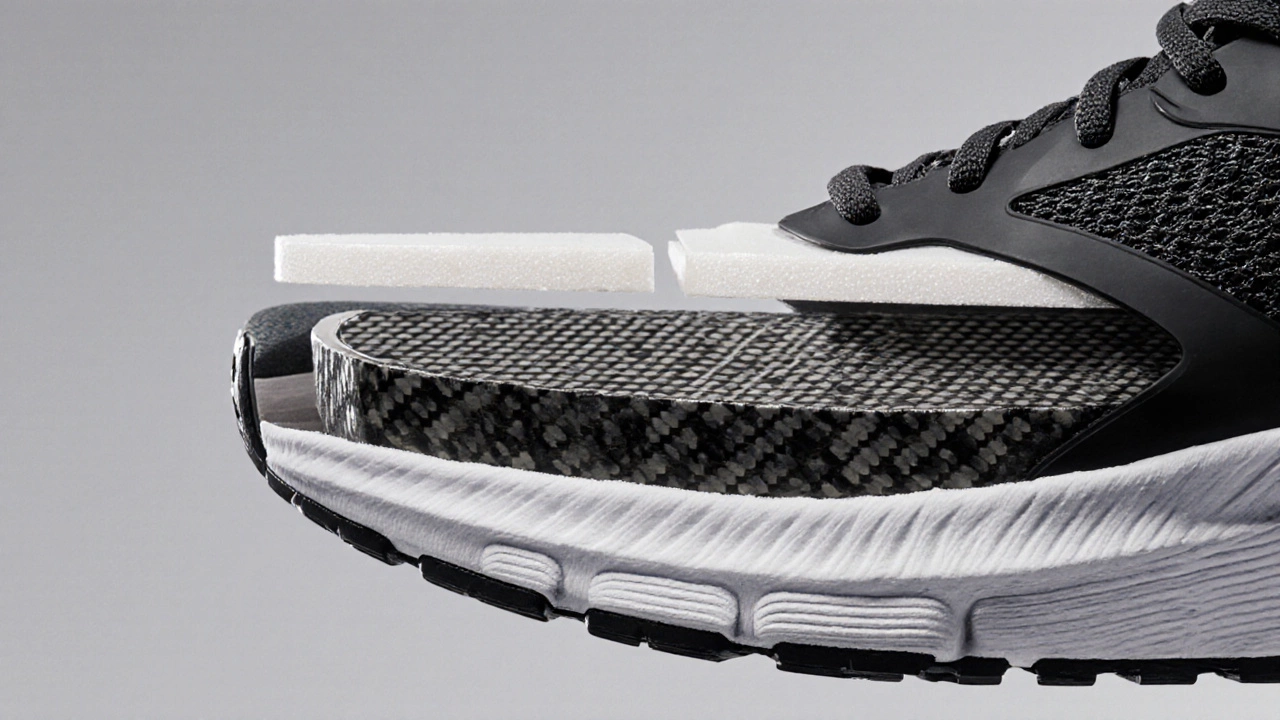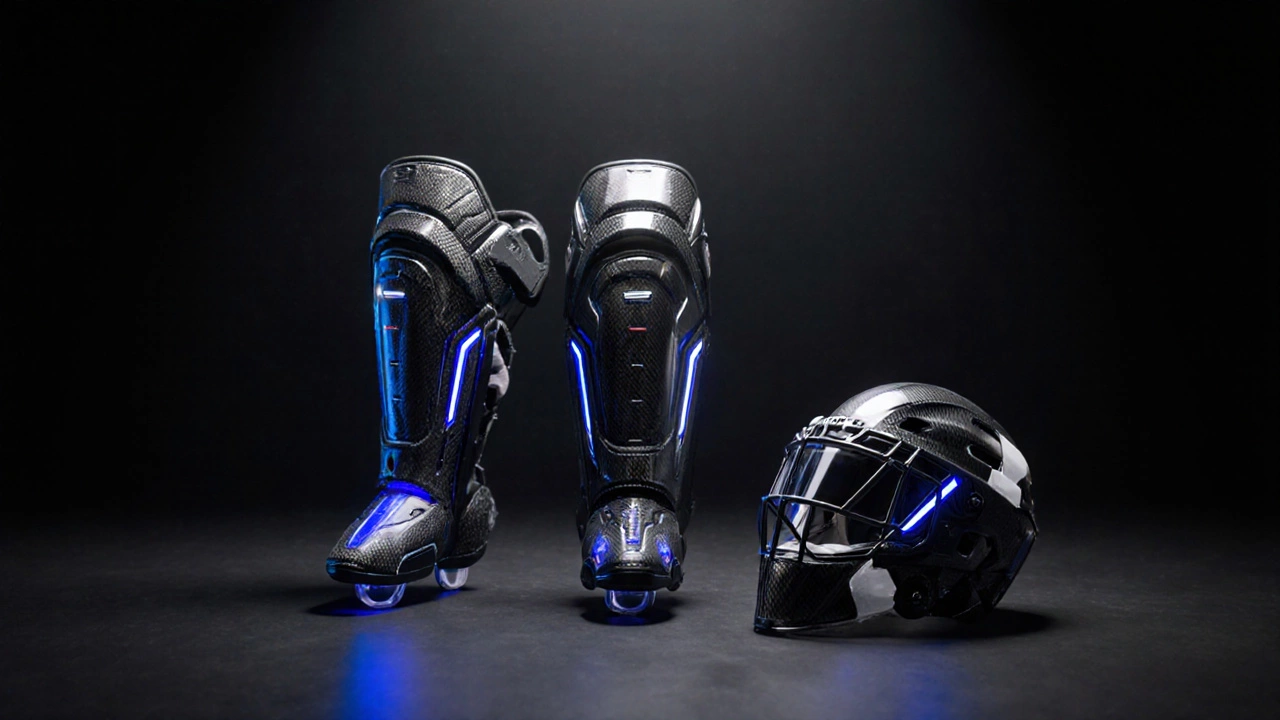What Are Sports Equipment Made Of? Materials Behind Your Gear

Sports Gear Material Advisor
Find the best materials for your sports gear
Select your sport, activity level, and priorities to get personalized material recommendations for your equipment.
Ever picked up a basketball and wondered why it feels so bouncy? Or held a baseball bat and noticed how light yet strong it is? The answer isn’t magic-it’s materials. Every piece of sports equipment you use is built from a mix of science, history, and smart engineering. Knowing what these items are made of helps you choose better gear, understand why it performs the way it does, and even spot when something’s wearing out.
Footwear: From Rubber Soles to Carbon Fiber Plates
Running shoes aren’t just foam and fabric. Modern running shoes combine at least five different materials, each doing a specific job. The outsole is usually made of rubber-often high-abrasion carbon rubber for durability on pavement. Midsoles are mostly EVA foam (ethylene-vinyl acetate), a lightweight cushion that absorbs impact. Higher-end models use PEBA (polyether block amide), a more responsive foam that returns more energy-used in shoes like Nike’s ZoomX or Adidas’ Lightstrike Pro.
The upper part? That’s typically mesh for breathability, reinforced with TPU (thermoplastic polyurethane) strips for structure. Some racing shoes even have a carbon fiber plate embedded in the midsole. That plate isn’t for stiffness-it’s a spring that helps push your foot forward with each stride. Marathon runners in the 2024 London Marathon wore shoes with carbon plates that improved efficiency by up to 4% compared to older models.
Balls: Leather, Synthetic, and Composite Skins
Not all balls are created equal. A soccer ball used in the World Cup isn’t the same as the one your kid kicks in the backyard. Professional soccer balls use synthetic leather-often polyurethane (PU)-because it grips better, handles wet weather, and lasts longer than old-school leather. Leather absorbs water, gets heavy, and can warp. PU doesn’t.
Basketballs? Same story. NBA balls are made of composite leather, a blend of synthetic materials that mimic real leather’s feel without the maintenance. Indoor courts need grip; outdoor courts need durability. That’s why outdoor basketballs use rubber or thermoplastic elastomers, which won’t crack in cold weather.
Tennis balls are covered in felt, usually a blend of wool and nylon. That felt wears down fast, which is why they’re replaced every few games. Inside, the core is made of rubber pressurized with air-or sometimes filled with nitrogen for slower deflation.
Protective Gear: Foam, Plastic, and Carbon Fiber
Helmet padding? It’s not just sponge. Most helmets use EPP (expanded polypropylene) or EPS (expanded polystyrene) foam. These materials crush on impact to absorb energy-then don’t bounce back. That’s why you can’t reuse a helmet after a big hit.
Shoulder pads in football? Layers of polyethylene plastic shells over foam padding. The plastic spreads force across a wider area. Some high-end pads now include gel inserts that shift under pressure to customize fit and shock absorption.
Hockey gear takes it further. Shin guards use composite materials-layers of fiberglass, carbon fiber, and dense foam. These are lighter than old metal guards but offer the same protection. Goalie masks? Made from fiberglass-reinforced plastic with a polycarbonate visor that can stop a 100 mph slapshot.

Rackets, Bats, and Sticks: The Rise of Composites
Wood is mostly gone from elite sports equipment. A baseball bat today is either aluminum or composite-a mix of carbon fiber, fiberglass, and resin. Composite bats flex on impact, creating a trampoline effect that sends the ball farther. That’s why many leagues ban them for youth play-they’re too powerful.
Tennis rackets? Almost all are made of graphite (a form of carbon fiber). It’s stiff, light, and strong. Higher-end models add kevlar for shock absorption or titanium for added power. The strings? Usually nylon or polyester. Polyester lasts longer and gives more spin; nylon is softer and more forgiving on the arm.
Hockey sticks are pure tech. The shaft is carbon fiber wrapped around a foam core. The blade is often a mix of carbon and fiberglass. These sticks weigh under 400 grams but can withstand hundreds of slapshots. A 2023 NHL study found that carbon fiber sticks increased shot speed by 12% compared to wooden sticks from 2010.
Other Gear: The Hidden Materials
Swimwear? Made of polyester or PBT (polybutylene terephthalate). These materials resist chlorine better than nylon and don’t stretch out. Olympic swimmers wear full-body suits made of polyurethane blends-though those are now banned for competitive use because they gave too much buoyancy.
Weightlifting bars? Made of steel, usually chromed or coated with zinc to prevent rust. The sleeves that spin? They use ball bearings or needle bearings inside sealed housings. The knurling (the textured grip) is machined into the steel-not added on.
Rowing oars? Carbon fiber again. Lightweight, stiff, and designed to flex just enough to store and release energy with each stroke. A single oar can cost over £500 because of the labor-intensive layup process.

Why Material Choice Matters
It’s not just about performance-it’s about safety, cost, and sustainability. A cheap soccer ball made of low-grade PVC might look fine, but it’ll crack in winter and won’t respond well. A $200 running shoe with a carbon plate might help your times, but if you’re a casual jogger, a $80 shoe with EVA foam will do just fine.
Also, materials affect how gear ages. Rubber degrades in sunlight. Foam compresses over time. Carbon fiber doesn’t rust, but it can crack under stress. Knowing this helps you spot when it’s time to replace something-not just because it looks worn, but because it’s lost its function.
What’s Next? Sustainable Materials Are Coming
Brands are starting to shift. Adidas made a running shoe with soles made from ocean plastic. Nike’s Flyknit uses recycled polyester yarn. Some hockey sticks now use bio-based resins instead of petroleum-based ones. Even tennis balls are being redesigned: Wilson now sells a ball with a felt made from 80% recycled materials.
The future of sports gear isn’t just lighter or faster-it’s cleaner. And as materials improve, so will performance. But for now, the best gear is still the one that matches your sport, your body, and your budget-with the right mix of rubber, foam, plastic, and fiber.
What material is most common in sports equipment?
The most common material across sports equipment is synthetic polymer-based plastics-especially polyethylene, polyurethane, and polyester. These are used in everything from shoe soles and ball covers to protective padding and clothing. They’re cheap, durable, and easy to mold into complex shapes. Rubber and foam are also extremely common, especially for cushioning and grip.
Are natural materials still used in sports gear?
Yes, but rarely at the elite level. Leather is still used in some baseball gloves and traditional rugby balls, but most have switched to synthetic alternatives for consistency and weather resistance. Wool is still found in tennis ball felt and some socks for moisture control. Natural rubber was once standard for balls and soles, but now most are made with synthetic rubber blends that perform better and last longer.
Why do some sports gear feel heavier than others?
Weight depends on material density and purpose. Equipment designed for protection-like football pads or hockey gear-uses dense plastics and foam to absorb impact, making them heavier. Gear meant for speed-like running shoes or cycling helmets-uses lightweight carbon fiber and thin composites. A heavy racket might give you more power, but it’ll tire you out faster. It’s a trade-off between control, power, and fatigue.
Can I recycle old sports equipment?
Some yes, most no-yet. Most sports gear is made of mixed materials that are hard to separate. But companies like Nike and Recycle Your Sports Gear offer take-back programs. They break down shoes into rubber, foam, and fabric, then reuse them in playground surfaces or new products. Tennis balls are collected and ground up for court padding. Check local programs-recycling isn’t widespread, but it’s growing.
Do materials affect injury risk?
Absolutely. Poor cushioning in shoes can lead to shin splints. Stiff rackets can cause tennis elbow. Hard-shell helmets without proper foam padding increase concussion risk. Even the surface you play on interacts with your gear-concrete with rubber-soled shoes creates more joint stress than synthetic turf with a responsive midsole. The right materials reduce impact, improve fit, and support natural movement.
